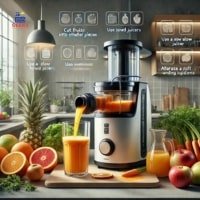How To Juice Without A Juicer
Juicing has become a popular way to consume essential nutrients and boost overall health. While a juicer is a convenient tool for extracting fresh juice, it’s not always necessary.
Today we’ll explore various methods for juicing without a juicer, providing you with effective alternatives that can help you enjoy fresh, nutrient-rich beverages right from your kitchen.
How To Juice Without A Juicer
Before diving into the various methods, here’s a list of basic tools and equipment you might need:
- Blender: A versatile tool for pureeing fruits and vegetables.
- Manual Citrus Press: Ideal for extracting juice from citrus fruits.
- Food Processor: Useful for breaking down vegetables and fruits.
- Cheesecloth or Fine Mesh Strainer: To filter out pulp from the juice.
- Potato Masher: For manually extracting juice from softer fruits and vegetables.
- Bowls and Containers: For collecting and storing the juice.
1. Manual Citrus Juicing
Best for: Oranges, lemons, limes, and grapefruits.
How-To:
- Cut the Citrus: Slice the citrus fruit in half.
- Use a Manual Juicer: Utilize a manual citrus juicer or reamer to extract the juice. Apply firm pressure while twisting to ensure maximum juice extraction.
- Strain if Necessary: If you prefer pulp-free juice, strain it through a fine mesh sieve or cheesecloth.
2. Blender Method
Best for: Soft fruits, leafy greens, and some vegetables.
How-To:
- Blend the Ingredients: Place chopped fruits or vegetables into a blender. Add a small amount of water if needed to help with blending.
- Blend Until Smooth: Blend on high until the mixture is smooth.
- Strain the Mixture: Pour the blended mixture through a fine mesh sieve or cheesecloth to separate the juice from the pulp.
3. Food Processor Method
Best for: Vegetables like carrots, cucumbers, and fruits with higher water content.
How-To:
- Process the Ingredients: Cut fruits or vegetables into smaller pieces and process them in a food processor until finely chopped.
- Extract the Juice: Transfer the mixture to a cheesecloth or fine mesh sieve. Squeeze or press to extract the juice from the pulp.
4. Grater and Cheesecloth Method
Best for: Hard fruits and vegetables, such as apples, beets, and carrots.
How-To:
- Grate the Produce: Use a fine grater to grate the fruit or vegetable into a bowl.
- Extract the Juice: Place the grated mixture into cheesecloth or a fine sieve and squeeze or press to extract the juice.
5. Mortar and Pestle Method
Best for: Soft fruits and herbs.
How-To:
- Crush the Ingredients: Place fruits or herbs into a mortar and use the pestle to crush them thoroughly.
- Extract the Juice: Transfer the crushed mixture to a fine mesh sieve or cheesecloth and press to extract the juice.
Tips for Maximizing Juice Yield
- Use Ripe Produce: Ripe fruits and vegetables have higher juice content and better flavor.
- Add Water Sparingly: Only add enough water to help with blending or processing; too much can dilute the juice.
- Strain Thoroughly: Make sure to strain the juice thoroughly to remove all pulp and achieve a smooth texture.
Why Juice Without a Juicer?
Before diving into the methods, let’s explore why you might choose to juice without a juicer:
- Cost-Effective: Juicers can be expensive. Using alternative methods can save you money.
- Space-Saving: Not everyone has room for an additional kitchen appliance.
- Convenience: If you’re looking to make a quick juice without the hassle of cleaning a juicer, these methods can be incredibly convenient.
Health Benefits of Fresh Juice
Drinking fresh juice provides numerous health benefits:
- Nutrient-Rich: Fresh juice is packed with vitamins, minerals, and antioxidants.
- Hydrating: Juice helps keep you hydrated, especially when made with water-rich fruits and vegetables.
- Digestive Health: Juice made from fibrous vegetables can support digestive health and regularity.
Common Juicing Mistakes to Avoid
- Over-Processing: Over-blending or processing can lead to a frothy texture and loss of nutrients.
- Ignoring Pulp: The pulp contains valuable nutrients and fiber. Consider using it in recipes or as compost.
- Using Too Much Water: Adding excessive water can dilute the flavor and nutritional value of your juice.
Conclusion
Juicing without a juicer is entirely possible with the right methods and tools. Whether you use a blender, food processor, or simple manual techniques, you can enjoy fresh, homemade juice without investing in a specialized appliance. By following these methods and tips, you’ll be able to create delicious and nutritious juices right in your kitchen, boosting your health and wellness in a cost-effective and convenient way.



